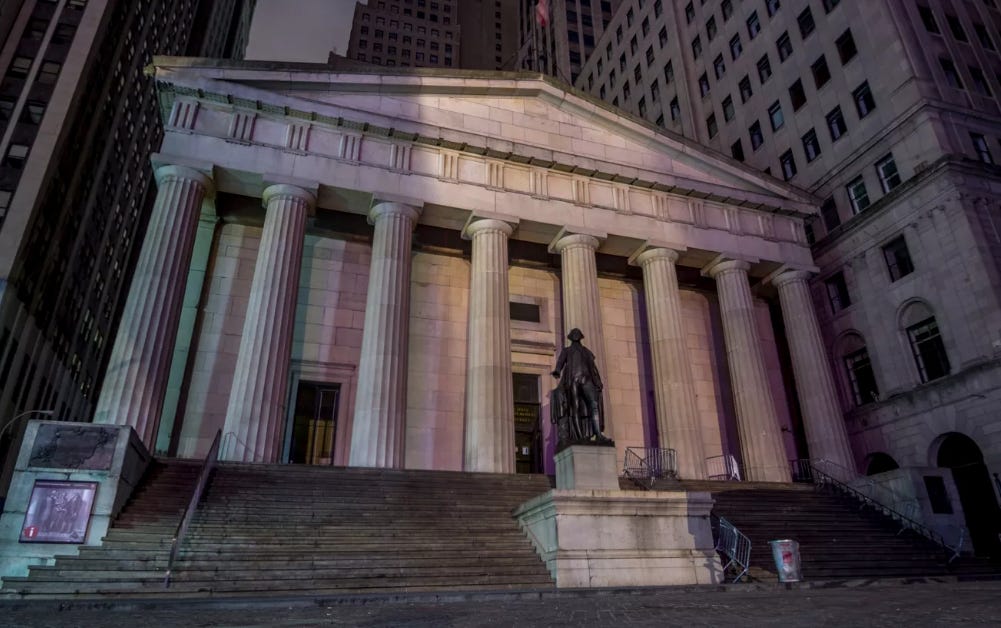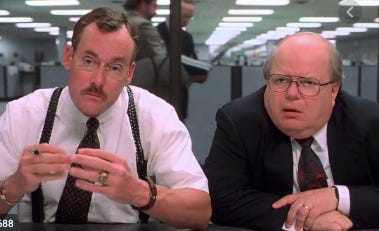Hi,
Welcome to BIG, a newsletter about the politics of monopoly. If you’d like to sign up, you can do so here. Or just read on…
Last month, New York City faced an intense heat wave, and two power outages in a row. Today I’m going to dig into how we’ve allowed the systems that keep us alive degrade, using New York City’s recent experience with its main utility Con Edison as an example.
But first…
News
Attorneys General to Move Forward With Antitrust Probe of Big Tech (Wall Street Journal) I’ve been saying the states are the most important forum for prosecutions of big tech, and Congress is where the pressure will come from. This story validates that thesis.
Some Friendly Chats Between Big Tech and Its Regulators (The American Prospect)
The Curious Transformation of Mike Lee (Google Transparency Project) This is a good review of how and why Utah Senator Antitrust Subcommittee Chair Mike Lee flipped from one of Google’s strongest foes to its biggest defender. Lee’s been big-footed by Republican Lindsay Graham, who outranks him.
Are GSA’s IG recommendations to cancel McKinsey’s schedule contracts too harsh? (Federal News Network) The whole government contracting space is a giant inefficient cash handout. Thank you Al Gore and reinventing government!
Should we be paying for Google My Business features? (Search Engine Land)
America’s CEOs Seek a New Purpose for the Corporation (Fortune) This is a big deal, even if it’s just rhetorical.
Viacom and CBS Executives to Earn Big Bucks in Merger Deal (Wall Street Journal) Acting CBS Chief Executive Joe Ianniello gets $70 million for the merger, and Viacom Chief Executive Bob Bakish will be paid $31 million a year for four years. The real rationale for mergers is often these payouts, as Sarah Miller and I wrote in No More Payoffs For Layoffs a few months ago.
Deadly banana fungus reaches Latin America (FT) We may no longer have bananas anymore because the main genetically identical variety is highly susceptible to a fungus. One of the dangers of mono-cultures is that a deadly disease can kill everything and there’s no resiliency. Not dissimilar to monopolies in key industrial sectors…
And now…
This is a beautiful photo in New York after Hurricane Sandy. And it tells a powerful story.

Three Swords Over New York
Electrical blackouts are scary things. On July 13th of this year, New York City had a blackout that lasted for five hours. The subway stopped along several lines, people were trapped in elevators, Carnegie Hall and Broadway theaters shut down, and Jennifer Lopez was cut off in at her concert at Madison Square Garden.
New York Governor Andrew Cuomo and New York City Mayor Bill De Blasio blamed Con Edison, the New York utility that manages most electric power in the city. And why shouldn’t they? Just before the blackout, Con Ed president Tim Cawley embarrassingly said, “By any measure, we are the most reliable electric delivery system in the United States."
The next weekend, it happened again, this time in Brooklyn.
Blackouts in New York City reflect the politics of the time. In 1965, and then again in 1969, Con Edison had massive outages that inspired frustration with what Americans perceived as an overall breakdown of the New Deal order. In 1977, it got worse, and there was widespread looting during a city-wide blackout during the rolling New York City financial crisis. The Carter and then Reagan eras of deregulation and concentrated capital were in many ways framed against the old, over-regulated, and antiquated systems represented by Con Edison, and in a bigger sense, New York City of the 1970s. In New York, partial deregulation of utilities finally came in 1997, and with this deregulation came a reduction in the amount of auditing by New York regulators.
We are beyond the Reagan era, of course, because that system is breaking down. Every age gets the metaphorical crises it deserves, and New York’s came in 2012, when Hurricane Sandy hit the city and caused power outages across half the city. I was there, and at first everyone was really nice to each other. Within a few days, a Mad Max vibe began to creep into daily interactions. The lights came back on in time to get the city more or less back to normal, though not everywhere.
The storm was the immediate cause of the blackout, of course, but the storm took advantage of an electrical infrastructure weakened by years of poor investment choices. We know this because a few months after the storm, the Utility Workers of America, the union negotiating with Con Edison, released a report on the company’s operational practices, alleging that “Con Edison appears to operate its electric distribution system based on a policy of“run it until it fails.’”
The details of Con Ed’s operations are ugly. The union noted a lack of redundancy in voltage equipment, smart meters paid for by the stimulus that were never turned on, and a lack of basic supplies. “Our members have worked on cable so old,” said the report, “that it has paper insulation, and on utility poles that were installed in the 1930s and remain in service today.”
The company used to have a policy of keeping a “safety stockpile” of basic supplies on hand in the event of an emergency. No longer. So when Sandy hit, Con Ed ran out of utility ladders and utility cable. It had to rush order parts that did not work on Con Ed systems, including “entire truckloads of utility transformers” which the utility could not return “because of their specialized nature.”
Imagine that. Before Hurricane Sandy hit the city, Con Ed didn’t bother stocking up on ladders. Ouch.
Obviously the union wants to show how its workers are valuable and deserve higher compensation, but the report is consistent with what we're seeing in corporate America more generally. The union’s motivations are also consistent with what the engineers at Boeing wanted, which was to do their job with integrity.
More broadly, what these new blackouts reflect is two things. First, they show the stresses that climate change are putting on our society. Sandy in 2012 and the heat waves in July pressured the electric grid. Second, they reflect how the short-term financialized mentality that is now pervasive among American policymakers and corporate leaders weakened the grid. It’s similar to what’s happening in Puerto Rico, where an electric grid ruined by years of corruption and financial pressure from bondholders was destroyed by a storm.
The blackouts in July show that the problems revealed during Sandy have not been fixed. I spent time this weekend going through some of Con Edison’s investor documents. And what I found is similar to what I found with Boeing. That is, this is a company focused on financial returns more than engineering integrity. Mainly what I noticed, and this is a fairly trivial observation, is that while Con Ed promised to radically improve its operations after the disaster, what it actually did is increase its dividend every single year and pay its CEO $10 million. I suspect the blackouts last month are one of the results.
But a dysfunctional Con Edison is just the first problem with New York City’s infrastructure.

The second big problem is the Hudson tunnel, the nation’s busiest railroad route, connecting New York City to New Jersey. The tunnel was built in 1910 and is on the verge of collapse. In 2009, as part of the stimulus, there was the money to rebuild what everyone knows is the most important piece of crumbling infrastructure in America. But then- New Jersey Governor Chris Christie killed it to attack Obama and promote himself as a Presidential candidate, Obama didn’t do anything about it, and Trump has refused to move forward on a new attempt. Concrete is falling apart in the remaining tube.
In other words, a good chunk of New York’s transportation infrastructure could collapse, at any point.
But beyond the political choice, contracting in America is insanely expensive and difficult. The high speed rail in California promised in the stimulus is basically dead, even though that did get approval, because costs ballooned. So even if we wanted to fix the Hudson tunnel, it would cost far too much to do so.
I don’t have a good analysis of why construction is so expensive in America, but this is my thesis in a picture.

To put it into words, the problem we have is corruption in the government contracting world, aided by immense amounts of useless overpaid make work. In 2011, an antitrust attorney did a report on how we overpay for government contracting. In service of ‘shrinking government,’ policymakers chose to set up a system where instead of hiring an engineer as a government employee for, say, $120,000 a year, they paid a consulting firm like Booz Allen $500,000 a year for a similar engineer. The resulting system is both more expensive and more bureaucratic.
Here’s one example I grabbed from a public government contracting schedule. The rate negotiated by the government’s General Services Administration for Boston Consulting Group is $33,063.75/week to get a single relatively junior contractor.

Most top tier management consulting is useless. It boils down to telling executives they should raise prices or avoid taxes in a fancy way, helping one faction in a corporation win an internal battle against another, or aiding a cowardly leader do something he or she knows she should do but is afraid of doing without outside validation. It’s highly overpaid make-work, which is why the movie Office Space resonated.
This corruption wasn’t that bad until the 1990s, when Bill Clinton and Al Gore introduced their ‘reinventing government initiative,’ which transferred large amounts of government work to overpaid private contractors. They bragged the size of government didn’t grow, even as they were building a slothful, incompetent, and highly corrupt shadow government in place of the relatively functional public system they took over. This trend of offshoring wasn’t just Federal, but state-level as well. Twenty five years later we’re dealing with a government that can’t govern.
Aside from Con Ed, and the Hudson tunnel, there’s a third problem facing New York City. Food. New York’s food supply nearly turned into a crisis during Sandy, largely because of corporation consolidation. Here’s Siddhartha Mahanta in 2013:
Until relatively recently, most of the food that wound up in New Yorkers’ stomachs came from the farms of upstate New York, Connecticut, and New Jersey. Even Brooklyn and Queens helped out, for a long while registering as the nation’s two biggest vegetable-producing counties.
When that locally grown food got to New York, it tended to stay around longer, sitting in warehouses for perhaps weeks at a time.
Now, New Yorkers rely chiefly on food from across the country, or the other side of the world. And to complicate matters, in recent decades the big companies that run these systems have radically altered how they manage the flow of this food through their supply chains. Most of the private companies that now dominate the distribution of food in America, like Walmart and Sysco, keep much smaller inventories than in years past, sized to meet immediate demand under stable conditions—a strategy known as "just-in-time." Analysts, in fact, expect Sysco—a major presence in the New York region—to continue cutting down an already super-lean supply chain operation.
In other words, the food on New York’s shelves flows through supply lines that stretch much further than ever before. And there’s a lot less of it along the way.
In other words, we have pooled risk in hidden ways and masked that with the appearance of financial profits. At Boeing it means the company was generating gobs of cash, but planes started crashing. In New York City, that means residents are vulnerable to losing electricity and food, and to transit collapses. Pretty important stuff, no?
Andrew Cuomo, the current Governor of New York, is part of the problem. His defining experience, in my view, was his alleged attempt in 1988 to take over a South Florida Savings and Loan bank and drain the bank of its assets. This revealed that Cuomo’s a financialization guy at heart. The regulators he’s appointed to deal with Con Ed likely see the world the way the executives at Con Ed do, he ignores the food system problem because he doesn’t recognize problems with concentration, and he believes in the corrupt contracting model. (There’s a reason he can’t fix the subway; he doesn’t know how.)
There’s a political rebellion going on all over American society because it’s obvious our leaders can’t handle the job we’ve given to them. I just hope the rebellion succeeds before a crisis really shows us why that rebellion needs to succeed.
Thanks for reading, and if you enjoy this newsletter, please share it on social media, forward it to your friends, or just sign up here.
cheers,
Matt Stoller
P.S. I found this email from a reader on how the problem of concentration is global fascinating.
After spending childhood and youth in Copenhagen the past five years in DC, I find it often useful to read your stuff from a lens of both places.
Here just a few thoughts on how avoiding capital concentration has been hard to avoid for Scandinavian style welfare states as well: The Scandinavian lesson of the recession in the 80-ties was to defer spending in order to curb inflation. The unions were forced to bury their policy goal of economic democracy and instead to settle with employee-owned pension funds. Fast forward 30 years and a sizeable chunk of available capital now sit with these Bruenig style pension funds. And guess what these funds are working on: Bonds, minimal SME investments, and preferably PPPs with governments to run things like buildings, bridges, and other large infrastructure with a guaranteed return. All stuff that governments just used to build, but today is blocked from doing thanks to the EU budget law. Many of my talented colleagues from college days now sit at either pension funds or the state-owned energy company. They are all smart people and believe that you need to put capital behind the energy transition (industrial policy, yay!). Yet it all just feels very brittle and orchestrated, as the fundament is thin, politically negotiated margins generated from financial agreements between made in a closed circuit between the state and the pension funds.
So the interesting question that you ask - how is it possible to produce a more decentralized political economy - remains highly relevant, also outside the US.

